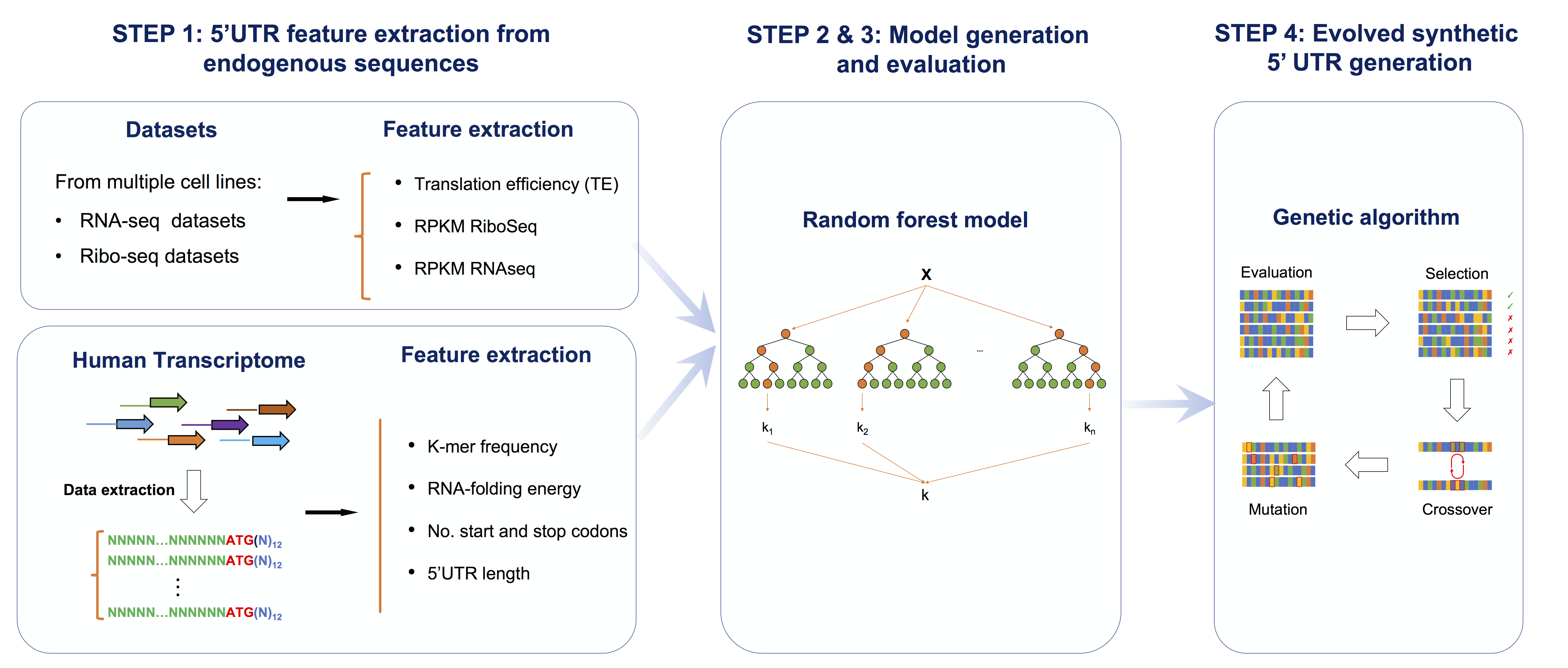The goal of this workflow is to generate novel 5'UTR sequences with optimized features to maximize the translation efficiency of the constructs. This is achieved in 4 steps:
- Step 1. Feature extraction from endogenous sequences
- Step 2. Model generation using extracted features to predict Translation Efficiency (TE)
- Step 3. Model evaluation using Spearman correlation, root mean square error and 10-fold cross-validation
- Step 4. Generation of novel 'evolved' sequences using a Genetic Algorithm
This repository is the code accompanying the paper:High-Throughput 5’ UTR Engineering for Enhanced Protein Production in Non-Viral Gene Therapies. Jicong Cao*, Eva Maria Novoa*, Zhizhuo Zhang*, William C.W. Chen, Dianbo Liu, Gigi C G Choi, Alan S L Wong, Claudia Wehrspaun, Manolis Kellis, Timothy K Lu. bioRxiv 2020. doi: https://doi.org/10.1101/2020.03.24.006486
- Step 1. Feature extraction of 5'UTR sequences
- Step 2. 5'UTR model generation
- Step 3. 5'UTR model evaluation
- Step 4. Generation of novel evolved 5'UTR sequences
- Additional data sources
- Dependencies and versions
- Citation
- Contact
Goal: Extract features that correspond to optimal 5'UTRs to maximize the translation efficiency (TE).
The features extracted from endogenous sequences (which will be used to generate models later) are:
- K-mer frequency: k=1-6
- RNA folding energy for: i) the first 100bp of the 5'UTR, ii) last 30bp(15bp UTR+ 15bp CDS), iii) whole (5UTR+15bp CDS), iv) 5'UTR only, with/without considering G-quadruplex
- Codon usage (of the 15 first bp of the CDS region)
- Number of start and stop codons in teh 5'UTR
- 5'UTR length
python run_pipeline.py feature_extract --input_fasta data/gencode_v17_5utr_15bpcds.fa --output_dir output/
Goal: Generate model that correspond to optimal 5'UTRs to maximize the translation efficiency (TE).
Algorithm used: Random Forest (--model 1) to build a prediction model is recommended, however the user can also choose to run glmnet, Rpart and SVM.
The model trained for human sequences is available as part of this repository.
python run_pipeline.py model_build --prefix output/input.fa --annotation_file data/df_counts_and_len.TE_sorted.Muscle.with_annot.txt --min_rna_rpkm 5 --min_riboseq_rpkm 0.1 --model 1 --out output/muscle_randomforest.model
Goal: Models are evaluated in terms of Spearman correlation, root mean square error and 10-fold cross-validation.
Results: Using 10-fold cross-validation, we obtained 0.71 Spearman correlation in TE prediction, and 0.74 in RNA expression prediction.
Note: This module can also be used to evaluate/compare the performance of models with different machine learning algorithms. If the the user finds that a different machine learning algorithm performs better, then should go back to step #2 and re-generate the model with a different machine learning algorithm (step #2 generates models with 100% of the data).
python run_pipeline.py model_eval --prefix output/input.fa --annotation_file data/df_counts_and_len.TE_sorted.Muscle.with_annot.txt --min_rna_rpkm 5 --min_riboseq_rpkm 0.1 --modellist 1,2,3,4 --out output/muscle_eval.xlsx
Goal: Evolve endogenous 5'UTR sequences to obtain 5'UTRs with increased translation efficiency
Algorithm used: Genetic Algorithm (GA)
Additional details of individual steps are described in makefile file)
python run_pipeline.py sequence_generate --n_total 3585 --prefix output/input.fa --annotation_file data/df_counts_and_len.TE_sorted.Muscle.with_annot.txt --min_rna_rpkm 5 --min_riboseq_rpkm 0.1 -t ribo -m output/muscle_randomforest.model -o output/
- df_counts_and_len.TE_sorted.with_annot.txt: Muscle RNA-seq and Ribo-seq data from publicly available datasets (PC3, HEK and muscle)
- entiredata_2015_12_25_3-25_pm: RNA binding motif, downloaded from http://cisbp-rna.ccbr.utoronto.ca/
conda env create -f environment.yml
Here we list the specific versions of individual dependencies needed:
| Software | Version |
|---|---|
| python | 3.5 |
| viennarna | 2.1.9 |
| R | 3.5.1 |
| biopython | 1.72 |
| r-randomforest | 4.6.14 |
| r-ga | 3.2 |
| r-seqinr | 3.6.1 |
| r-glmnet | 2.0.16 |
If you find this work useful, please cite:
High-Throughput 5’ UTR Engineering for Enhanced Protein Production in Non-Viral Gene Therapies. Jicong Cao*, Eva Maria Novoa*, Zhizhuo Zhang*, William C.W. Chen, Dianbo Liu, Gigi C G Choi, Alan S L Wong, Claudia Wehrspaun, Manolis Kellis, Timothy K Lu. bioRxiv 2020. doi: https://doi.org/10.1101/2020.03.24.006486
If you have any issues using this code, please open an Issue in the GitHub repository. Thanks!
